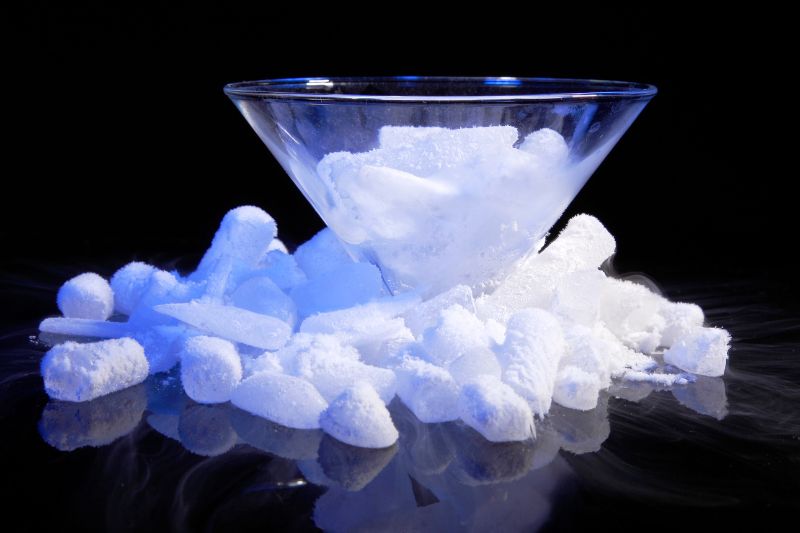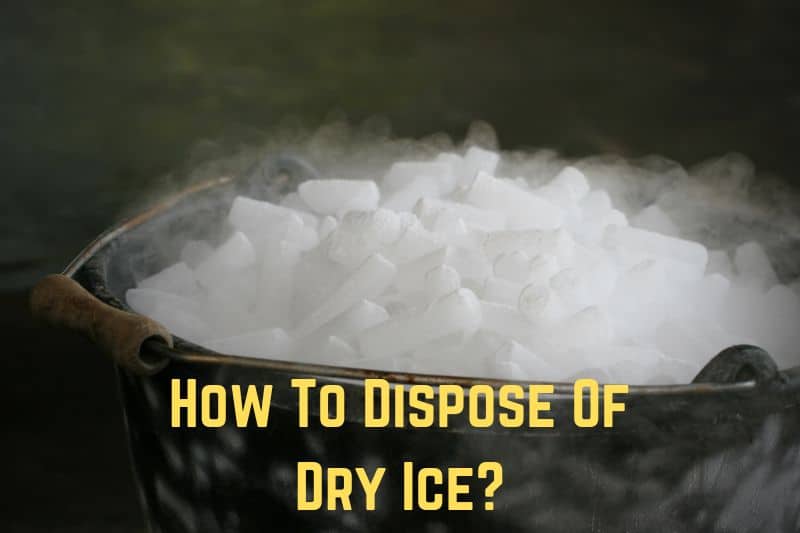Using dry ice has gained popularity during the past few years. You can use dry ice goods to simplify your life, including cleaning materials, removing scale, rust, paint, and chilling essential food products.
The only issue that most people have is knowing how to properly and safely dispose of dry ice. There are other approaches to take, however.
You must take care of several things in addition to correctly disposing of dry ice to prevent any unfavorable events. The proper handling and disposal of dry ice will be covered in this article, along with the safety precautions to take. Let us start now!
What is Dry Ice?
Solid carbon dioxide is what makes up dry ice. Dry ice is produced when carbon dioxide is subjected to pressures or temperatures below -109.2 degrees Fahrenheit. Low temperatures will allow the dry ice to melt or vaporize.
Shops for groceries and home goods frequently carry dry ice. They are usually used to move temperature-sensitive things, carry out studies in science, and create condensation effects. They come as blocks, pellets, or flakes. Dry ice demands extra caution because of the incredibly low temperatures that it must operate in.
Dry ice can be produced with ease. A gas having a substantial carbon dioxide content is the starting point for the most popular commercial process of producing dry ice. These gases may result from another procedure, such as the production of ammonia from natural gas and nitrogen, the operations involved in oil refineries, or massive fermentation.
The gas that is high in carbon dioxide is then cooled and under pressure until it liquefies. The pressure is then decreased. This vaporizes some liquid carbon dioxide, rapidly lowering the remaining liquid’s temperature.
The outcome is that the liquid solidifies into a consistency akin to snow due to the intense cold. Finally, dry ice is produced by compressing the snow-like frozen carbon dioxide into smaller pellets or larger blocks.
Safety Precautions When Handling Dry Ice
Dry ice is a strong cooling substance with an average temperature of -109 degrees Fahrenheit that is frequently used for storing food, eradicating scars or skin tags, carbonate fluids, and more.
However, due to its extremely low temperature, those working or interacting with dry ice should adhere to several fundamental safety considerations to avoid harm.
1. Put On Insulated, Thick Gloves
Never handle dry ice with bare hands is the cardinal rule of handling it. Although it may appear to be a typical ice cube, the extremely high surface temperature could lead to burns or frostbite. Use a scraping tool and a set of thick, adequately insulated gloves to move dry ice safely and to safeguard your hands from arctic conditions.
2. Put On Protective Glasses
When working with dry ice, safety glasses should always be used. Although dry ice-related eye injuries are uncommon, it is better to be cautious than sorry. Industrial-grade protective goggles will shield your eyes from flying fragments and dry ice.
3. Avoid Keeping in Airtight Containers
Avoid putting dry ice in airtight containers; this is a crucial safety precaution. Consider dry ice an expanding chemical, comparable to a shaken and tossed Coke bottle.
It may explode with sufficient pressure inside its storage box, spewing shrapnel in every direction. Storing dry ice inside a plastic bag is okay, but it needs a tiny break to let the pressure out.
4. Work in a Well-Ventilated Area
Suffocation is a risk connected with the use of dry ice that many individuals are unaware of. Dry ice emits carbon dioxide as it transforms into a gas. This is fine in an area with good ventilation because the carbon dioxide would disperse.
Nevertheless, using dry ice within a constrained area could cause the carbon dioxide to displace the oxygen, posing a serious risk of suffocating.

Methods To Dispose of Dry Ice
Start by eliminating the dry ice in a well-ventilated location at room temperature. As a result, there will not be any risks when the dry ice sublimates or instantly changes from solid to gas. Safety should be a high concern while disposing of dry ice. To ensure a simple and secure transaction, follow the following detailed guidelines.
1. Pick the Appropriate Location and Time
For dry ice disposal, pick a space that has good ventilation. Do it outside, such as in a yard, fire escape, or open windows. Make sure no animals or children can enter the area. Select a clear day as the time.
2. Wear the Proper Disposal Gear
Put on the necessary gear to protect yourself. Handling dry ice requires insulated gloves, like these winter or oven mitts. To prevent contact with the dry ice, you ought to sport lengthy sleeves, protective glasses, and closed-toe shoes.
3. Allowing Sublimation of Dry Ice
Wear insulated gloves and put the dry ice on an even, well-ventilated surface. Allow it to evaporate or sublimate. To avoid excessive carbon dioxide gas exposure, keep away from the region.
4. Give It At Least a Day To Sit
Wait at least a day for the leftover dry ice to dissipate in the well-ventilated space completely. If you need to dispose of much dry ice swiftly, you can break it into tiny fragments or pour hot water over it while wearing thermal gloves and safety goggles.
5. Correctly Dispose of the Equipment
Use the appropriate disposal method to remove the used equipment after the dry ice completely transforms into carbon dioxide gas. Collect the disposal surface, safety equipment, and airtight container. Please put them in a sealed container and discard them in an explosive waste facility.
Can You Pour Dry Ice Down the Sink?
Although you may speed up the dry ice removal process using hot water, you should not do so in a sink. The pieces of the kitchen sink may become damaged by the dry ice’s extremely low temperatures.
Do not simply leave dry ice in your kitchen sink or the drain if you accidentally drop it there. Your pipes will burst as a result of the water freezing in them. Instead, continuously run hot water through your sink.
Dry ice will sublimate (transform into gas) in hot water, and continuous flow will prevent it from freezing. The high temperature can completely fracture your ceramic sink if you have one. Therefore, damage can still be done regardless of whether the dry ice is not moving down the drain.
Depending on the dry ice you have poured down your sink, you must turn on the hot water for however long it takes. If you only place one or two dry ice cubes in the kitchen sink, it will disappear in a few minutes.
Environmental Impact of Dry Ice Disposal
In ordinary life, dry ice is not poisonous and does not significantly threaten the environment. Nevertheless, it still affects the environment during production and after disposal, so it needs to be managed and disposed of properly.
Among the constituents of dry ice, carbon dioxide is released when it melts and is known as a gas that absorbs heat (the greenhouse effect). Dry ice and other carbon dioxide-containing gases can absorb solar energy, warming the earth’s surface and atmosphere and contributing to climate change.
However, by adopting carbon dioxide cleaning technology, dry ice blasting can be prevented from contributing to these impacts of climate change.
How Long Does Dry Ice Last?
The duration of dry ice can be determined in a variety of ways. The length of time depends on the dry ice block’s size and the storage circumstances. When kept in a Styrofoam cooler, dry ice lasts 24 hours.
The lone exception to this rule is a regular-sized cooler containing up to two dry ice blocks. The dry ice can last roughly 3–4 days with additional dry ice blocks inside the huge Styrofoam. Dry ice generally stays longer in a cooler, more insulated storage area. Dry ice will, however, evaporate if kept outside for three to five hours.
A dry ice pack can be kept for several days if it is kept in a well-insulated, airtight cooler. Proper handling and storage are required to increase dry ice’s shelf life. Dry ice is best stored in an insulated cooler with the lid open.
FAQ’s
How do you get rid of dry ice?
Dry ice should be disposed of by leaving it at room temperature in a well-ventilated area; the remaining ice will melt away. Never put dry ice into the garbage, a container for chemical waste, or any other trash or waste container.
Can You melt dry ice with water?
A thick, white fog will be produced immediately when warm water is added to a container tightly sealed or filled with dry ice. Similar to how a vapor or fog forms in open nature, the white mist is made up of an emulsion of tiny water molecules. The extremely cold, dry ice sublimates from its solid form to its gaseous state, creating a thick, white fog.
What happens if you flush dry ice?
Carbon (IV) Oxide is the substance that makes up dry ice. Due to the coldness, running water will eventually freeze instead of dissolving. Your pipes can rupture, which would cause excessive damage.
Conclusion
Since dry ice is distinct from regular ice, it must be used and disposed of differently. Employ Styrofoam or an insulated vessel when storing dry ice. Now that we know how to get rid of dry ice properly, it is crucial to let it dissipate and to keep dry ice outside in well-ventilated places.






